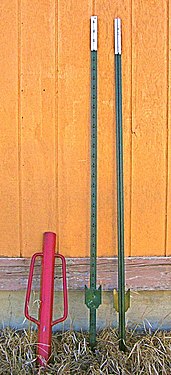A steel fence post, also called (depending on design or country) a T-post, a Y-post, or variants on star post, is a type of fence post or picket. They are made of steel and are sometimes manufactured using durable rail steel. They can be used to support various types of wire or wire mesh. The end view of the post creates an obvious T, Y, or other shape. The posts are driven into the ground with a manual or pneumatic post pounder. All along the post, along the spine, there are studs or nubs that prevent the barbed wire or mesh from sliding up or down the post. They are generally designated as 1.01, 1.25 or 1.33, referring to the weight in pounds per lineal foot. They are commonly painted with a white tip on top; white improves the visibility of the fence line. When driving the post with a post pounder the white top paint is a visual means to ensure the user doesn’t raise the pounder too high while pounding. Raising the pounder too high allows it to lean towards the user and could lean to striking them in the head.
While T-Posts are more common in the United States, Y-posts are more common in Australia and New Zealand where they are sometimes called either star pickets or "Waratahs", after the company which registered a patent for them in 1926. In New Zealand Waratahs are often used for trail blazing.
In areas (such as the British Isles) where treated timber is relatively inexpensive, wooden fence-posts are used and steel ones are unusual for agricultural purposes. In the British Isles steel posts are however often used for fencing into solid rock. In this case a hole is drilled into the rock, and the post is fixed using cement or epoxy. In Australia these are normally called a star picket and sizing is by length, normally one notch on the top and holes down the length. They are often covered in a black bituminous coating.
-
 A steel post on a standard seven wire fence in New Zealand.
A steel post on a standard seven wire fence in New Zealand.
-
 End-on view of a T-post, showing the T-shape that gives the post its name.
End-on view of a T-post, showing the T-shape that gives the post its name.
-
 Two T-posts and red post pounder (or driver) used to drive them into the ground. The flat plate helps stabilize the post, which is driven into the ground until the plate is buried.
Two T-posts and red post pounder (or driver) used to drive them into the ground. The flat plate helps stabilize the post, which is driven into the ground until the plate is buried.
See also
References
- Outback magazine, "Outback Story", Issue 62, Jan/Dec 2009